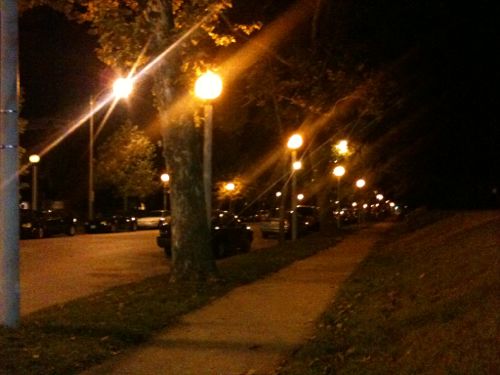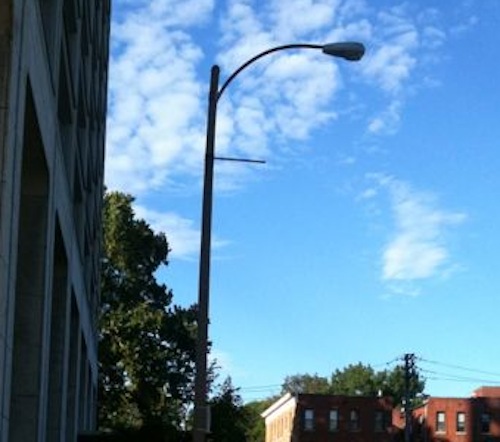Updated Street Lighting on Taylor

In July new lighting was turned on along a short stretch of Taylor, a description from June:
The Taylor Pedestrian Lighting project is nearly complete. When finished, Taylor Ave between Forest Park Parkway and Lindell Ave will be illuminated by pedestrian lights rather than cobra-head lights. The pedestrian lights will make that stretch of Taylor Ave more attractive and safer for pedestrians at night, and will better connect Taylor south of Lindell to Taylor north of Lindell, which already has pedestrian lighting installed. Pedestrian lighting is another initiative to make the Central West End and the 17th Ward a more walkable, pedestrian-friendly, and vibrant community.
The $330,000 project was funded by various sources, including $60,000 from Washington University Medical Center, $30,000 from Central West End South Business District, and $100,000 from block grant. The remaining funding came from the 17th Ward Infrastructure Funds allocated by Alderman Joseph Roddy. (Source)
It seemed bright at first but the night I was out taking pictures I noticed it was about the same as some areas north of Lindell. These lights aren’t as tall as the cobra head lights that are common throughout the city. These lights equally light the street and sidewalk.

The cobrahead fixtures are taller, spaced further apart and directed toward the road rather than the sidewalk. I’m glad to see this change, but I’m disturbed these types of changes happen only within a single ward. Corridors involving more than one ward are probably out of luck.
– Steve Patterson
It’s hard to tell from your photo, but it appears that the new “pedestrian” lights aren’t very energy efficient since they appear not to be directional, aiming light only toward the ground. I also disagree that most city sidewalks are poorly lit. They may not be illuminated to the levels of the adjacent streets (which have way too much lighting), but they are lit well enough to walk safely.
While the traditional “cobra heads” are pretty mundane, they do their jobs well, aiming their light primarily at the ground, and distributing it fairly evenly. “Pedestrian” lights really only serve two purposes, to light pedestrian walkways that are not adjacent to streets (as on college campuses or in the interior of parks) and they can be used to add sparkle to the built environment (as they have along Taylor and on some of our city viaducts).
If anything, the city needs to think about doing less lighting, not more. It takes energy to leave lights on all night, and we have a light level in the city that is excessive. We could eliminate half our cobra heads with no impact on safety and cut our utility bill in half. And we need to make a commitment to use only directional fitures with sharp cut-offs – put light on the ground, not shing into adjacent properties, and certainly not shining up into the night sky (and wasted)!
It’s hard to tell from your photo, but it appears that the new “pedestrian” lights aren’t very energy efficient since they appear not to be directional, aiming light only toward the ground. I also disagree that most city sidewalks are poorly lit. They may not be illuminated to the levels of the adjacent streets (which have way too much lighting), but they are lit well enough to walk safely.
While the traditional “cobra heads” are pretty mundane, they do their jobs well, aiming their light primarily at the ground, and distributing it fairly evenly. “Pedestrian” lights really only serve two purposes, to light pedestrian walkways that are not adjacent to streets (as on college campuses or in the interior of parks) and they can be used to add sparkle to the built environment (as they have along Taylor and on some of our city viaducts).
If anything, the city needs to think about doing less lighting, not more. It takes energy to leave lights on all night, and we have a light level in the city that is excessive. We could eliminate half our cobra heads with no impact on safety and cut our utility bill in half. And we need to make a commitment to use only directional fitures with sharp cut-offs – put light on the ground, not shing into adjacent properties, and certainly not shining up into the night sky (and wasted)!
I’m not a huge fan of this style of fixture as light can go up although I think they’ve minimized that somehow. The cobrahead fixtures often have bright spots with dark spots in between. My experience has been they light the road more than the sidewalk.
So put up more poles, and change the angle of the cobra-head.
(BTW my “like” was meant to be a “reply”)
I’m not a huge fan of this style of fixture as light can go up although I think they’ve minimized that somehow. The cobrahead fixtures often have bright spots with dark spots in between. My experience has been they light the road more than the sidewalk.
i’m not sure that directionality has anything to do with energy-efficiency… the “aiming” of the light is achieved with mirrored surfaces. the bulb itself still emits light in all directions, and the power dissipated is determined by what happens inside the bulb (e.g. heating of the filament).
i’m not sure that directionality has anything to do with energy-efficiency… the “aiming” of the light is achieved with mirrored surfaces. the bulb itself still emits light in all directions, and the power dissipated is determined by what happens inside the bulb (e.g. heating of the filament).
You want a certain level of brightness below the light. If some of the light is going up and disappearing, you need a more energy intensive bulb so that the same amount of light reaches the ground.
(My “like” was meant to be a “reply” AGAIN…)
right. good point.
So put up more poles, and change the angle of the cobra-head.
(BTW my “like” was meant to be a “reply”)
You want a certain level of brightness below the light. If some of the light is going up and disappearing, you need a more energy intensive bulb so that the same amount of light reaches the ground.
(My “like” was meant to be a “reply” AGAIN…)
right. good point.
Change of angle and use of some other fluorescent bulbs would solve the problem rather than changing the poles.
Change of angle and use of some other fluorescent bulbs would solve the problem rather than changing the poles.